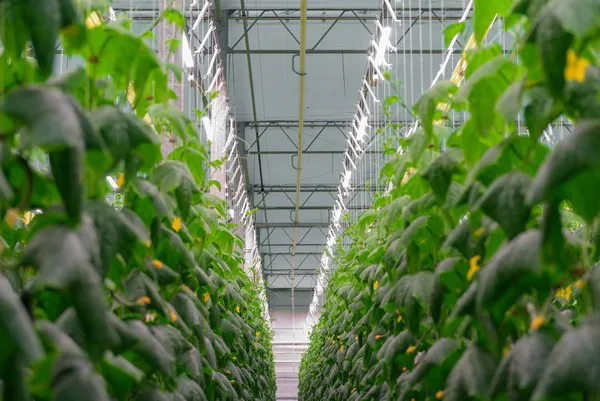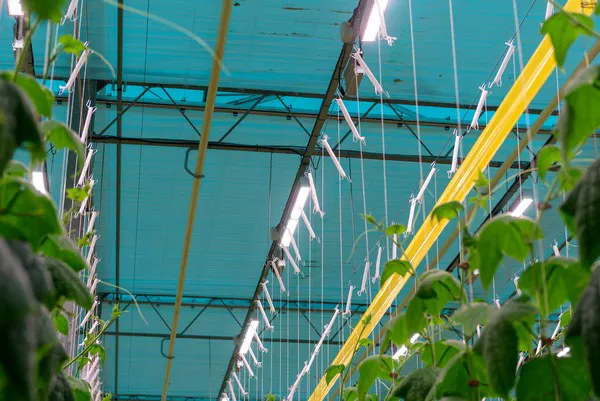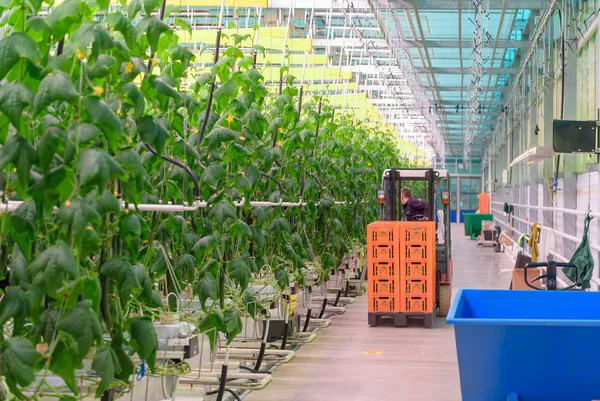The Getlini greenhouses out of Latvia have been labeled ‘one of the most modern greenhouses in the world’ because of their effort to combine sustainable innovations with horticulture. Their greenhouses are indeed built next to a landfill. The waste there is used to produce power and heat that is supplied directly to the cultivations. On top of that, they were the first grower to use LEDs to grow cucumbers commercially. “Since the first greenhouse was built here, we heavily invested in the latest technologies,” Ricards Ozolins from Getlini EKO explains. “Waste gas contains methane, which is one of the most valuable components. This is collected with holed pipes, which are placed every 6 meters into the waste layers. When the gas is pumped out, it gets delivered to the automatic gas regulation stations and ultimately sent to the power unit. In that, the gas gets burned, thus producing electricity and heat. We use that for the office, technical rooms, and waste processing, as well as for the greenhouse. While we mainly rely on waste gas for the greenhouse, we have also installed an emergency unit that can provide the necessary heat if the situation arises.”

High-degree control
It shouldn’t come as a surprise that the Getlini EKO greenhouses are equipped with all sorts of high-tech to control everything down to the smallest details and reduce to the max the impact on the planet. For instance, climate ‘stations’ in the greenhouse monitor the environment. Tomatoes and cucumbers are grown in rock wool, an inert medium that provides optimal root oxygenation. Bumblebee colonies fly through the cultivation to pollinate tomato flowers. Next to that, beneficials protect the plants from harmful pests and pathogens. “In this way, we don’t have to use any chemical spray and keep the high quality of our produce intact.”

Sensors installed all over the greenhouses help Getlini keep track of everything that is going on. “With the use of wireless sensors and our data platform, Getlini can monitor crop development in near real-time and see how changes in the greenhouse environment are affecting plant development,” says Andris Stuks from Synergy Solutions, the supplier of the plant monitoring system. “By benchmarking running season with previous ones, we can see where we have made better decisions, and Getlini can learn from their past mistakes, as they are recorded and visible. For instance, Getlini can see their light use efficiency on the fly.”
Experimenting with lights
That surely is an important feature for the grower. This is because, this year, the company has changed its lighting system from HPS to LED to reduce energy consumption and increase plant productivity. “We replaced 600W/400V HPS lamps with Fluence VYPR 3p Broad R8 lamps while maintaining the existing electrical system, which allowed us to increase the lighting level by 60%.” Getlini pursued sustainability even further and created custom software with Synergy Solutions and Fluence to increase control over the lights. “In this way, we can create a super precise lighting schedule and be very efficient with our energy consumption.”

Getlini EKO was also the first greenhouse grower who switched entirely to LED for cucumber cultivation. “Our season starts in October and ends in June next year,” Ricards says. “We cooperated with Philips in their cucumber trials in research greenhouses to find those cucumber varieties that perform the best in our environment.” That’s why the selection of the LED lighting system was crucial to achieving the desired results. “Fluence shares our vision of innovation and high-tech,” he says. “The Fluence team ensured that the modernization of the greenhouse was carried out according to our needs. All the issues that came up during the design phase were resolved promptly.” Such support is instrumental when the grower is a horti pioneer like Getlini. “It was very difficult to find correct, publicly available information on LED modules and their capabilities,” Ricards points out. “It was a challenge for our agronomists to understand which spectrum would be the most suitable for our crops. That’s where Fluence support came into play.”

With an eye constantly on sustainable innovations, the future for Getlini may hold more than just tomatoes and cucumbers. “We have considered the possibility of growing medical cannabis, as it’s a very high-value crop,” he says. “We are in contact with several pharma companies that could use our raw materials for manufacturing painkillers. At the same time, medical cannabis is still not allowed in Latvia. It is, however, allowed in Lithuania, and the EU Commission should be working on a plan to develop the MMJ industry there. In that case, production costs would increase substantially as there would be a lot of regulations to comply with. For now, growing medical cannabis is just an idea. It might be more than that if the regulatory situation changes.”

